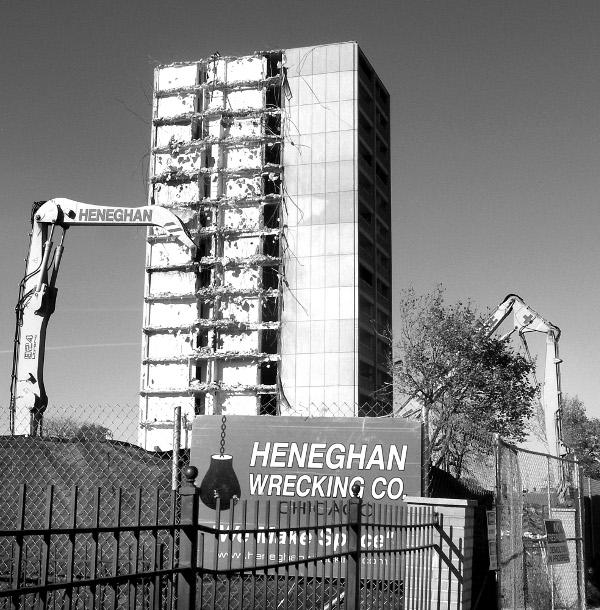
PHOTO/JOSEPH PEERY
CHICAGO IL — Our cities are undergoing a profound transformation. Industrial manufacturing is being replaced by high-tech production. But while technology gives us the possibility of a brighter future, in the hands of the ruling class it has brought us poverty, a loss of jobs and lower wages. What follows is an increase in evictions, homelessness and gentrification. Public housing would solve a lot of those problems, but is being systematically dismantled. Few communities illustrate this process better than Cabrini Green on Chicago’s Near North Side.
Three-fourths of the Cabrini row houses remain vacant. Fences, cameras and security keep the homeless out. Homelessness, which has been increasing since the 2007 great recession, now numbers more than 125,000 persons according to the Chicago Coalition for the Homeless. Wouldn’t now be the time for more public housing? In fact one of the reasons given for why Cabrini was originally constructed was to help World War I veterans who were made homeless by the great depression. So how is it that public housing is born under one set of circumstances and seems to be dying under very similar circumstances 80 years later?
The answer cannot be found in the partisan politics of Democrat versus Republican. Each president, starting with Ronald Reagan, has done their part to dismantle public housing, regardless of party affiliation. The answer lies in the cold hard economic facts of the job market.
When Cabrini was built after the passing of the 1935 Public Housing Act, real estate companies opposed it, calling it socialist, because it was “bad for their business.” However, industrial manufacturers supported it because, no matter how low the slave wages were they paid public housing residents, only 30% of that was charged for rent. This super exploitation brought them millions in higher profits.
As industrialization expanded so did Cabrini with the completion of the Cabrini extensions in 1957 and the William Green Homes in 1962. By the late 1960s, that expansion ended. The area just south of Cabrini became known as “Ghost Town” because of the blocks of empty buildings that once housed businesses and jobs. The invention of the microprocessor in 1971 paved the way for the permanent replacement of human labor by machines. This was the beginning of the end for industrial manufacturing. One by one, companies like Montgomery Ward, Oscar Meyer and Turtle Wax either went out of business or left the area. Cheap Cabrini Green labor power was no longer needed.
This process is being repeated everywhere. Capitalism does not recognize a human right to housing and is unwilling to house anyone it does not need. So the ranks of the homeless swell alongside empty warm apartments. This same concept applies equally well to the other necessities of life like water, food, education and healthcare as well as ending police murder.
We must understand that when the system forces us to stand up and fight or lie down and die, what we are really actually fighting for is a whole new society that values human life. The new technology offers us the possibility of that bright future. It will begin to become a reality when enough of us become aware of that.
The historical importance of Cabrini Green
Latest
The People’s Tribune opens its pages to voices of the movement for change. Our articles are written by individuals or organizations, along with our own reporting. Bylined articles reflect the views of the authors. Articles entitled “From the Editors” reflect the views of the editorial board. Please credit the source when sharing: peoplestribune.org. Please donate to help us keep bringing you voices of the movement for change. Click here. We’re all volunteer, no paid staff. The People’s Tribune is a 501C4 organization.

